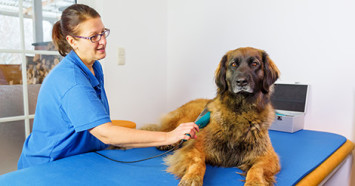
Confession: I’ve been wanting to buy this new toy for my practice called a “cold laser.” You may have heard of it. It’s this pricey piece of equipment (in the tens of thousands of dollars range) that doctors use to help patients with arthritis (and other sources of pain) feel better almost instantly.
If you haven’t heard of it, you might be wondering whether veterinary medicine has gone too far this time. But here’s the scoop: It’s all about making pets feel better in ways you’re likely to notice right away. What’s more, it’s especially good for patients who seem untreatable by conventional means. All you do is have them sit there quietly while you apply a non-painful problem to the surface of the skin. It’s magical.
The Great Unknown
Cold laser therapy (also known as low-level laser, class IV laser, photobiomodulation, and just plain “laser therapy”) seems to work, though we’re not exactly sure how. Unlike surgical and cosmetic lasers, it doesn’t discernibly heat the tissue (hence the term “cold laser”). We think it reduces inflammation by infusing affected body tissues with light. This red and near-infrared light elicits a reaction that we believe forces damaged cells to regenerate.
If it’s so wonderful, you may ask, why doesn’t every pet owner already know about it? And why doesn’t every veterinarian have one?
A few reasons:
a) As I mentioned, it’s a very expensive piece of equipment. I mean, it’s hard to justify spending Porsche-level sums for my practice when I have limited funds I should be allocating towards staff education, new fluid pumps, and other basic necessities.
b) That pricing trickles down to you, the pet parent. And when you, as a cash-strapped pet owner, see that a procedure costs more than a hundred bucks a session, you might think twice about it no matter how “miraculous” it may be.
c) The pain-relieving benefits are only temporary. Sometimes it lasts weeks, most times it’s just days, and in some patients it’s only a few hours (and some don’t experience relief at all). So even if it does work, you can be sure that you’ll be coming back for more of the same pricey service.
d) Some veterinarians are unconvinced – I was at first. I used to think that if this laser thing works so well, how is it that we don’t know exactly how? I mean, we even know how acupuncture works. Why can’t we figure out which cellular mechanisms are responsible for explaining how this works? And where’s the body of literature behind it?
To be sure, the scientific community is split on the efficacy of lasers. And that’s a big deal for a bunch of science nerds like veterinarians. Despite a high safety index (not a lot can go wrong here), there’s not a whole lot of evidence showing that laser therapy is anywhere nearly as effective as weight loss, NSAIDs, or even fatty acids when it comes to reducing inflammation or providing relief of pain.
Despite our skepticism, laser therapy, among other forms of alternative therapy for pets, is undeniably compelling. We love it for its ability to offer a direct relationship between the thing done and the result achieved, even if it doesn’t happen all the time. I mean, you can see where getting a rapid-relief response after applying a simple device to an ouchy spot might seem attractive to pet owners and veterinarians alike. We love knowing that we’re helping, and laser seems to do that for a great many pets.